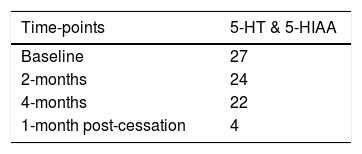Isotretinoin (13-cis retinoic acid) is a highly effective and commonly used treatment against acne vulgaris. Even though isotretinoin has been linked to low mood, depression, and suicidal ideation, a concrete link to adverse mood has not been proven yet, with some studies supporting this claim and others refuting it.1–6
Since isotretinoin crosses the blood-brain barrier, a biological mechanism linking isotretinoin to depression is plausible.3,7–10 In the adult brain, receptors for retinoids are widely expressed, and isotretinoin could potentially regulate the expression of several neuronal genes.8–10
Serotonin (5-HT) is a widely recognized neurotransmitter and a key mediator of mood. Imbalances in serotonin levels have been linked to low mood and depression.7,8 The present work’s objective was to pilot a study that tests the hypothesis that treatment with isotretinoin could lead to measurable changes in the concentration of key mood-related neurotransmitters. In order to do so, the authors performed a prospective cohort study assessing the effects of isotretinoin on the neurotransmitter’s’ serotonin (5-HT) and 5-HIAA (the main serotonin metabolite) in patients with acne vulgaris. Plasma levels of 5-HT and 5-HIAA were measured before, during, and after treatment with isotretinoin. Data were collected prior to treatment initiation, at two and four months of treatment, and one month after treatment cessation.
A total of 27 patients contributed blood prior to initiation of treatment. 24 and 22 patients had their serum measured at two and four months of treatment, respectively. Only four patients attended for blood testing one month after treatment cessation (Table 1).
At the pre-treatment baseline, the authors found the following mean values: 5-HT 10.66, 5-HIAA 74.77.
Mean values at 2-months of treatment were found to be: 5-HT 9.64 (p = 0.633), 5-HIAA 44.31 (p = 0.082). At 4-months of isotretinoin therapy values had changed to: 5-HT 13.07 (p = 0.349), 5-HIAA 32.83 (p = 0.294). These findings did not represent statistically significant changes from the baseline.
The disappointingly low numbers of patients that attended the follow-up appointment at one month after cessation of treatment did not allow for a meaningful statistical analysis of post-isotretinoin effects.
A detailed documentation of the findings over time, as well as the changing ratios of HT to HA, are presented in Table 2.
Nonparametric summary of the findings for 5-HT (HT), 5-HIAA (HA), and their ratio (HTHA) at baseline (0), 2-months (2), and 4-months (4) of treatment.
| Test results over time | Number of patients | Min | Lower quartile | Median | Mean | Upper quartile | Max | Wilcoxon matched-pairs signed-ranks tests |
|---|---|---|---|---|---|---|---|---|
| 5-HT_0 | 27 | 0.61 | 4.59 | 8.70 | 10.66 | 13.04 | 36.78 | Baseline comparator |
| 5-HT_2 | 24 | 1.26 | 5.89 | 7.60 | 9.64 | 11.54 | 28.32 | p=0.633 |
| 5-HT_4 | 22 | 1.07 | 6.34 | 9.78 | 13.07 | 14.77 | 56.10 | p=0.349 |
| 5-HIAA_0 | 26 | 7.05 | 14.77 | 26.23 | 74.77 | 74.86 | 502.30 | Baseline comparator |
| 5-HIAA_2 | 24 | 3.11 | 13.19 | 23.05 | 44.31 | 29.03 | 548.20 | p=0.082 |
| 5-HIAA_4 | 22 | 2.26 | 8.50 | 25.67 | 32.83 | 41.12 | 143.70 | p =0.294 |
| HTHA_0 | 26 | 0.012 | 0.098 | 0.249 | 0.605 | 0.527 | 5.220 | Baseline comparator |
| HTHA_2 | 21 | 0.015 | 0.203 | 0.312 | 0.475 | 0.496 | 1.803 | p=0.523 |
| HTHA_4 | 20 | 0.015 | 0.246 | 0.490 | 0.749 | 0.761 | 2.854 | p=0.244 |
The relationship between isotretinoin and adverse mood changes is a highly debated aspect of isotretinoin therapy.
The authors did not find a significant link between treatment with isotretinoin and changes in the neurotransmitters 5-HT, 5-HIAA, or the ratio of the two. If a causal link is present between the two, it is likely mediated via a different neurochemical pathway.
Having said that, the pilot study has a small number of patients and significant attrition in follow-up. Therefore, even though it can act instructively, this work cannot fully support this claim. Larger, prospective, case-controlled studies will likely be required in order to address in detail the link between mood, isotretinoin, and neurotransmitters. The authors hope that this work will act as guidance and inspiration for such further undertakings.
Financial supportNone declared.
Authors’ contributionsAdam P. Bray: Contributed to the design, recruitment, management, writing, and literature review associated with this study.
Georgios Kravvas: Contributed to the design, recruitment, management, writing, and literature review associated with this study.
Suzanne M. Skevington: Contributed to the design, recruitment, management, writing, and literature review associated with this study.
Christopher R. Lovell: Contributed to the design, recruitment, management, writing, and literature review associated with this study.
Conflicts of interestNone declared.
Study conducted at the Department of Dermatology of University Hospitals Bristol NHS Foundation Trust, Bristol, UK.





